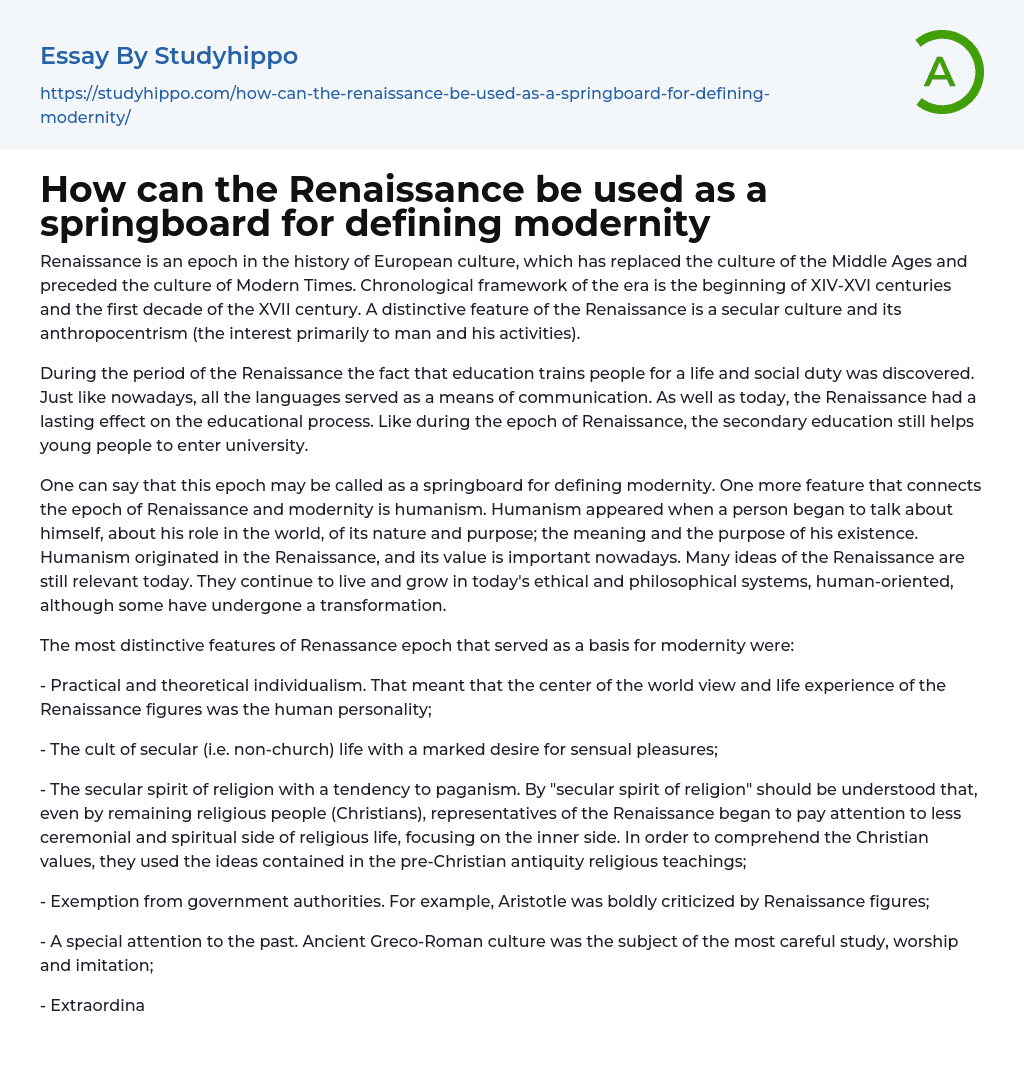

How can the Renaissance be used as a springboard for defining modernity Essay Example
Renaissance is an epoch in the history of European culture, which has replaced the culture of the Middle Ages and preceded the culture of Modern Times. Chronological framework of the era is the beginning of XIV-XVI centuries and the first decade of the XVII century. A distinctive feature of the Renaissance is a secular culture and its anthropocentrism (the interest primarily to man and his activities).
During the period of the Renaissance the fact that education trains people for a life and social duty was discovered. Just like nowadays, all the languages served as a means of communication. As well as today, the Renaissance had a lasting effect on the educational process. Like during the epoch of Renaissance, the secondary education still helps young people to enter university.
One can say that this epoch may be called as a springboard fo
...r defining modernity. One more feature that connects the epoch of Renaissance and modernity is humanism. Humanism appeared when a person began to talk about himself, about his role in the world, of its nature and purpose; the meaning and the purpose of his existence. Humanism originated in the Renaissance, and its value is important nowadays. Many ideas of the Renaissance are still relevant today. They continue to live and grow in today's ethical and philosophical systems, human-oriented, although some have undergone a transformation.
The most distinctive features of Renassance epoch that served as a basis for modernity were:
- Practical and theoretical individualism. That meant that the center of the world view and life experience of the Renaissance figures was the human personality;
- The cult of secular (i.e. non-church) life with a marked
desire for sensual pleasures;
- The secular spirit of religion with a tendency to paganism. By "secular spirit of religion" should be understood that, even by remaining religious people (Christians), representatives of the Renaissance began to pay attention to less ceremonial and spiritual side of religious life, focusing on the inner side. In order to comprehend the Christian values, they used the ideas contained in the pre-Christian antiquity religious teachings;
- Exemption from government authorities. For example, Aristotle was boldly criticized by Renaissance figures;
- A special attention to the past. Ancient Greco-Roman culture was the subject of the most careful study, worship and imitation;
- Extraordinary taste for the arts.
Renaissance rulers built plazas, orphanages, with a sense of their public duty. Nicola Machiavelli was the first who separated politics from morality. He also described the era when all states would act in their national interests.
It is important to bear in mind the differences between the Renaissance not only with current, but also with the subsequent period. Does Renaissance open a New Era Revival? In other words, whether it is the beginning of modern time? One cannot imagine modernity without the scientific and technical achievements. Science and technology are the factors without which modern society cannot exist. It will not be an exaggeration to say that the impact of science and technology in modern society extends to all aspects of life. This is typical of the industrial and postindustrial era. Dominance of science and technology opens the era following the Renaissance, - the era of Modern Times. Its beginning is usually attributed to the XVII century. Renaissance era is rather artistic and aesthetic
par excellence than era of innovations. What is more, some of the Renaissance artists attributed painting to science; Leonardo da Vinci believed that painting was the most important one of all Sciences.
In conclusion, it should be said that the period of Renaissance can be described as a burst of freedom for culture and thought. The Renaissance renewed the spirit of research and exploration among Europeans. This spirit moves the world today more than ever. However, one can hesitate, whether ideas of the Renaissance explain the moral issues of contemporary time the most adequately. This issue is quite controversial, but one should agree that Renaissance was the cradle of many modern ideas.
- Puritans essays
- Afterlife essays
- Buddhism essays
- Christianity essays
- Deism essays
- Faith essays
- God essays
- Hinduism essays
- Islam essays
- Jews essays
- Judaism essays
- Monotheism essays
- New Testament essays
- Ritual essays
- Sin essays
- Soul essays
- Theology essays
- Confession essays
- Devil essays
- Miracle essays
- Monk essays
- Revelation essays
- Atheism essays
- Immortality essays
- Jainism essays
- Sinners essays
- Bible essays
- Old Testament essays
- Salvation essays
- Temple essays
- Taoism essays
- Pilgrimage essays
- Freedom Of Religion essays
- Existence of God essays
- Christian Worldview essays
- Cosmological Argument essays
- Gautama Buddha essays
- Karma essays
- Buddha essays
- Baptism essays
- Holy Spirit essays
- Jesus Christ essays
- Adam And Eve essays
- Crucifixion Of Jesus essays
- Crusades essays
- Eucharist essays
- God The Father essays
- Pope essays
- Protestantism essays
- Christian essays



